Balance Sheets, Boards, Brands & Business Models
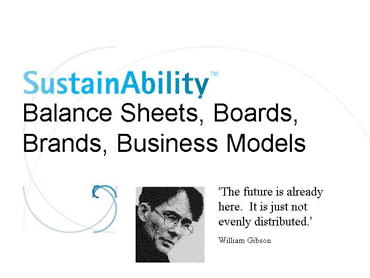
These days, I am trying to move well beyond the triple bottom line to areas where integration is happening - or is needed. Areas, that is, where business is pursuing what Jed Emerson calls 'blended value'. In quoting sci-fi author William Gibson, I am making the point that the future is already out there, if we know where to look. And while some of it may be headed towards sustainability (fuel cell technology, for example), some of it may not (think of 'dirty bomb' technology)
Shell, 1995-2010
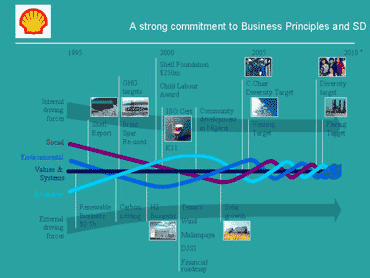
This slide, put together by Shell (www.shell.com), shows how the giant oil company is integrating (or blending, perhaps) the economic, social and environmental dimensions of the CSR and SD agenda into its business principles and management systems. The time scale runs from 1995, when Shell had its problems around the Brent Spar oil buoy and the executions in Nigeria, through to 2010. Shell has been a SustainAbility client since 1997.
The 4Bs
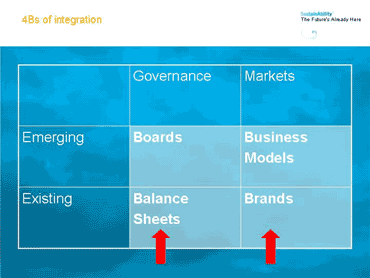
This slide, an early version of which I started using at the end of 2002, spotlights four areas where blended value will be sought: (1) Balance Sheets, e.g. accountability, accounting, reporting and assurance; (2) Boards, e.g. the realm of corporate governance; (3) Brands, e.g. the ongoing conversations between companies and their consumers, customers, investors and media; and (4) Business models, i.e. how companies create (or destroy) value. (1) and (2) I put in the realm of 'Governance', whereas (3) and (4) are more about 'Markets' - and that's where some of the biggest challenges now lie.
Paradigm Shift
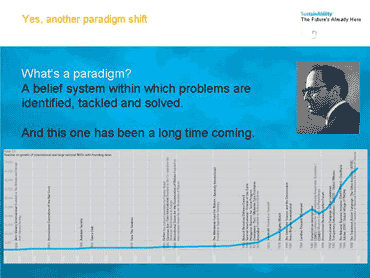
One of the most influential books I ever read was The Structure of Scientific Revolutions, by Thomas Kuhn. I read it in the late 1960s and the world has looked different to me ever since. This slide I use to make the point that the pressures business is now under have been building for well over a century, with the 1960s marking a step change: what Francis Fukuyama dubbed 'The Great Disruption'.
Trust/Environics
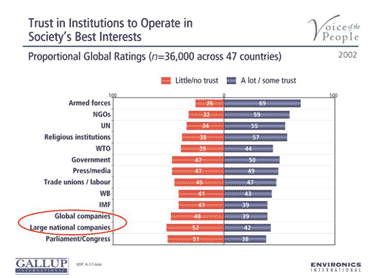
This slide, created by Environics International on the basis of surveys in 47 countries in 2002, shows levels of trust in various institutions. Business scored very low, while the armed forces (at least for a while in the wake of the 9/11 attacks) scored high. The low esteem that business is held in after scandals like those affecting Andresen and Enron may be good news for PR consultants, but it's bad news for anyone wanting to advance CSR or SD priorities with business and through markets.
Wright Brothers

In many ways, the sustainable development movement today is pretty much where the Wright Brothers were early in the 20th century. Many early SD experiments will crash and burn, but enough innovators will eventually succeed to ensure new industrial and social revolutions. The trick will be to get a sense of who has the best chances - and then to buy from, work for and/or invest in them.
TRIMARAN

When we were spotlighting the triple bottom line, I used trimarans to illustrate how three-dimensional objects can be closely linked, move fast and be highly manoeuvrable. The logo was used for SustainAbility's 'Trimaran' program on corporate governance and the role of boards.
Fish Cartoon

I asked Ingram Pinn, who does cartoons for the Financial Times, to illustrate something that (Professor) Tom Gladwin said in the early 1990s. This was that every board should have someone around the table representing the interests of Nature, of the poor and of future generations. This was the result - and I used it successfully for many years.
Wattbug

This slide shows the Wattbug, developed by a small team of Turkish designers, Mutlu Inc, in response to a competition (www.sustainer.org). The question was how to inform ordinary citizens about their energy usage and its implications. The Wattbug shows red and growls when energy use is high, shows amber and falls silent when it's moderate, and the green light goes on and the beast starts to purr when energy usage is sustainably low. The idea that each kitchen would have its energy meter in the kitchen or living room, almost like a pet, rather than as a battleship grey box under the stairs or outside, was a real innovation.
Soap

Peter Woodward made this comment during an event he facilitated in 2000 - and I liked it a lot.
Detergents

I used this slide together with the one below showing the consumer guides to make the point that the growing competition between consumer products in terms of their comparative environmental performance represented real progress - as long as the right product won. The problem in the late 1980s and early 1990s was that it wasn't always easy to tell which product was best. In this example, was Ecover better than Procter & Gamble's mainstream product? In some ways yes, but some early 'green' products didn't work as well as the mainstream products, with the result that consumers switched off - or even ended up using products that were inferior all around, on the strength of misleading environmental claims.
Values Shift
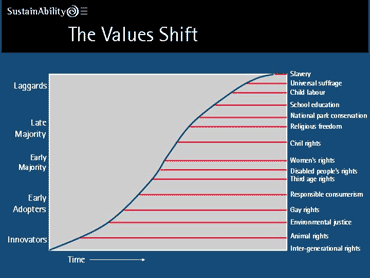
I developed this diagram for our 1995 report Who Needs It?. It aims to show values changing over time, what we called the 'Values Shift'. Only the 'Laggards' are still prepared to defend slavery, in its various forms, whereas the 'Innovators' are now starting to wrestle with issues like intergenerational justice.
Goldfish Bowl

Again, I'm not sure where this image came from, but it was a wonderful way of illustrating the hyper-transparent world, the 'goldfish bowl' in which business must increasingly operate.
The Green Consumer Guide

Some of the editions of our 1988 book The Green Consumer Guide. This slide was a way of establishing SustainAbility's credentials as an organisation that was (1) in touch with what a growing number of consumers wanted and (2) operating around the world.
6 = 9

I used this slide off and on for many years after we featured it in our 1988 book Green Pages. It struck me as a wonderful distillation of the perspectives that often dog interactions between different interest groups. Still can't find where it originally came from. Any ideas welcome.
Planet Earth

Over the years, I have used many different variants of the Earth seen from outside. These images, which first started to have a real impact in the early 1970s, helped reframe the discussion about humanity's future. Source: NASA